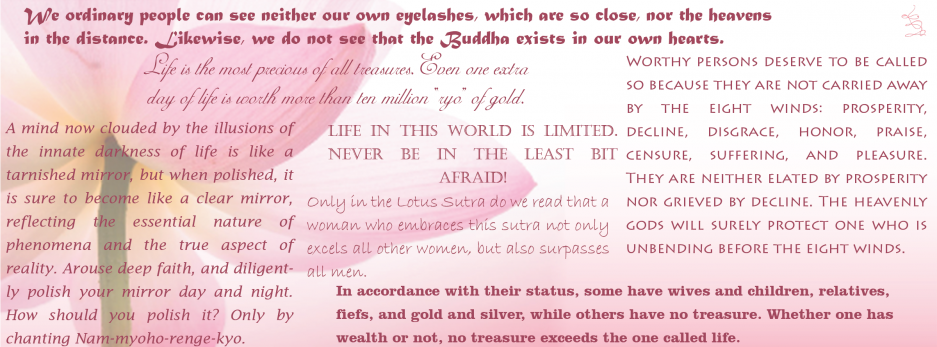Tags
Gosho, Letter to the Brothers, Lotus Sutra, Nichiren Buddhism, Nichiren Daishonin, The four devils, The three obstacles, Three Thousand Realms
The doctrine of three thousand realms in a single moment of life revealed in the fifth volume of Great Concentration and Insight is especially profound. If you propagate it, devils will arise without fail. If they did not, there would be no way of knowing that this is the correct teaching. One passage from the same volume reads: “As practice progresses and understanding grows, the three obstacles and four devils emerge in confusing form, vying with one another to interfere . . . One should be neither influenced nor frightened by them. If one falls under their influence, one will be led into the paths of evil. If one is frightened by them, one will be prevented from practicing the correct teaching.” This statement not only applies to me, but also is a guide for my followers. Reverently make this teaching your own, and transmit it as an axiom of faith for future generations.
The three obstacles in this passage are the obstacle of earthly desires, the obstacle of karma, and the obstacle of retribution. The obstacle of earthly desires is the impediments to one’s practice that arise from greed, anger, foolishness, and the like; the obstacle of karma is the hindrances presented by one’s wife or children; and the obstacle of retribution is the hindrances caused by one’s sovereign or parents. Of the four devils, the workings of the devil king of the sixth heaven are of this last kind.
In this passage, Nichiren Daishonin emphasizes that those who practice and propagate the correct teaching of Buddhism will invariably encounter obstacles, and that the appearance of such obstacles serves to confirm the validity of their practice. This is a fundamental principle of Buddhism and a major point of this letter.
The “doctrine of three thousand realms in a single moment of life” mentioned in the first sentence is the supreme philosophical achievement of the Great Teacher T’ien-t’ai (533-97) of China. It is set forth in Great Concentration and Insight, a compilation of T’ien-t’ai’s profound lectures recorded by his immediate disciple, Chang-an. Based on the Lotus Sutra, the doctrine of three thousand realms in a single moment of life clarifies the ultimate oneness of absolute reality (Buddhahood) and the phenomenal world (environment).
A life-moment refers to the reality or true state of an individual’s life at any given moment; and 3,000 refers to the diversity of potential states or conditions it can assume at that moment. T’ien-t’ai explained that a life-moment contains within it the Ten Worlds, their mutual possession (making 100 worlds), the ten factors (making 1,000 factors) and the three realms (making 3,000 realms). With this theory, T’ien-t’ai demonstrated that all phenomena-body and mind, self and environment, sentient and insentient, cause and effect-are integrated in the life-moment of the common mortal. One’s life at each moment actually contains the whole of reality and pervades the entire universe. However, T’ien-t’ai’s three thousand realms in a single moment of life refers in theory to the life of Buddhahood latent within all people. Therefore it is called the theoretical three thousand realms. In contrast, three thousand realms in a single moment of life, as set forth in the Buddhism of Nichiren Daishonin, refers to the means to manifest Buddhahood as a reality within the lives of all people.It is therefore called the actual three thousand realms.
Nichiren refers to three thousand realms in a single moment of life revealed in the fifth volume of Great Concentration and Insight because he wishes to stress the principle of the three obstacles and four devils set forth in that same volume. However, in terms of our own practice, we should understand it as referring to Nam-myoho-renge-kyo of the Three Great Secret Laws, and not to the theoretical three thousand realms in a single moment of life of T’ien-t’ai.
“The doctrine of three thousand realms in a single moment of life” is the teaching that enables ordinary, unenlightened people to become Buddhas. Therefore it is only natural that great obstacles attend its practice and propagation.
Overcoming the three obstacles and four devils through practicing and propagating the Law is the means to end the suffering that originates in our fundamental darkness. President Ikeda explains that “lessening karmic retribution means putting an end in this lifetime to the cycle of misery and misfortune that has continued in our lives from the distant past up to the present. Persecutions and obstacles present us with a golden opportunity to attain enlightenment. They are a springboard for greatly expanding our state of life. That transform the source of our suffering and bring forth the power to overcome it. When this transformation of our fundamental darkness takes place in the context of propagating the Law, our Buddha nature is strengthened to the utmost and we are assured of victory.
By overcoming unbelievable persecution and hardship, Nichiren proved to all of us that an ordinary person can attain Buddhahood through dedicated practice and propagation. He states “Here, a single individual has been used as an example, but the same thing applies equally to all living beings” (“The Unanimous Declaration by the Buddhas,” WND-2, 844). By using Nichiren as a model, however, does not mean we must experience the same persecution and hardship that he did.
December 2005, Living Buddhism
